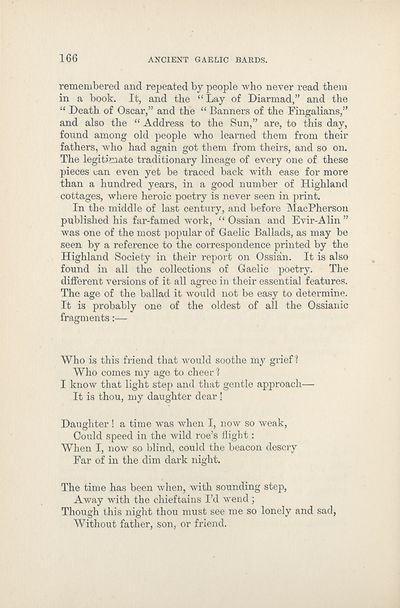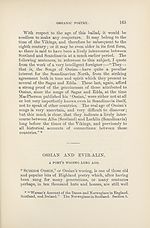Books and other items printed in Gaelic from 1871 to 1900 > Gaelic bards, and original poems
(200) Page 166
Download files
Complete book:
Individual page:
Thumbnail gallery: Grid view | List view

1G6
ANCIENT GAELIC BARDS.
remembered and repeated by people who never read them
in a book. It, and the “ Lay of Diarmad,” and the
“ Death of Oscar,” and the “ Banners of the Fingalians,”
and also the “ Address to the Sun,” are, to this day,
found among old people who learned them from their
fathers, who had again got them from theirs, and so on.
The legitimate traditionary lineage of every one of these
pieces can even yet be traced back with ease for more
than a hundred years, in a good number of Highland
cottages, where heroic poetry is never seen in print.
In the middle of last century, and before MacPherson
published his far-famed work, “ Ossian and Evir-Alin”
was one of the most popular of Gaelic Ballads, as may be
seen by a reference to the correspondence printed by the
Highland Society in their report on Ossian. It is also
found in all the collections of Gaelic poetry. The
different versions of it all agree in their essential features.
The age of the ballad it would not be easy to determine.
It is probably one of the oldest of all the Ossianic
fragments:—
Who is this friend that would soothe my grief ?
Who comes my age to cheer ?
I know that light step and that gentle approach—
It is thou, my daughter dear!
Daughter ! a time was when I, now so weak,
Could speed in the wild roe’s flight:
When I, now so blind, could the beacon descry
Far of in the dim dark night.
The time has been when, with sounding step,
Away with the chieftains I’d wend ;
Though this night thou must see me so lonely and sad,
Without father, son, or friend.
ANCIENT GAELIC BARDS.
remembered and repeated by people who never read them
in a book. It, and the “ Lay of Diarmad,” and the
“ Death of Oscar,” and the “ Banners of the Fingalians,”
and also the “ Address to the Sun,” are, to this day,
found among old people who learned them from their
fathers, who had again got them from theirs, and so on.
The legitimate traditionary lineage of every one of these
pieces can even yet be traced back with ease for more
than a hundred years, in a good number of Highland
cottages, where heroic poetry is never seen in print.
In the middle of last century, and before MacPherson
published his far-famed work, “ Ossian and Evir-Alin”
was one of the most popular of Gaelic Ballads, as may be
seen by a reference to the correspondence printed by the
Highland Society in their report on Ossian. It is also
found in all the collections of Gaelic poetry. The
different versions of it all agree in their essential features.
The age of the ballad it would not be easy to determine.
It is probably one of the oldest of all the Ossianic
fragments:—
Who is this friend that would soothe my grief ?
Who comes my age to cheer ?
I know that light step and that gentle approach—
It is thou, my daughter dear!
Daughter ! a time was when I, now so weak,
Could speed in the wild roe’s flight:
When I, now so blind, could the beacon descry
Far of in the dim dark night.
The time has been when, with sounding step,
Away with the chieftains I’d wend ;
Though this night thou must see me so lonely and sad,
Without father, son, or friend.
Set display mode to:
![]() Universal Viewer |
Universal Viewer | ![]() Mirador |
Large image | Transcription
Mirador |
Large image | Transcription
Images and transcriptions on this page, including medium image downloads, may be used under the Creative Commons Attribution 4.0 International Licence unless otherwise stated. ![]()
| Rare items in Gaelic > Books and other items printed in Gaelic from 1871 to 1900 > Gaelic bards, and original poems > (200) Page 166 |
|---|
| Permanent URL | https://digital.nls.uk/106038975 |
|---|
| Description | Out-of-copyright books printed in Gaelic between 1631 and 1900. Also some pamphlets and chapbooks. Includes poetry and songs, religious books such as catechisms and hymns, and different editions of the Bible and the Psalms. Also includes the second book ever published in Gaelic in 1631. |
|---|

